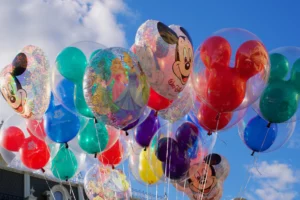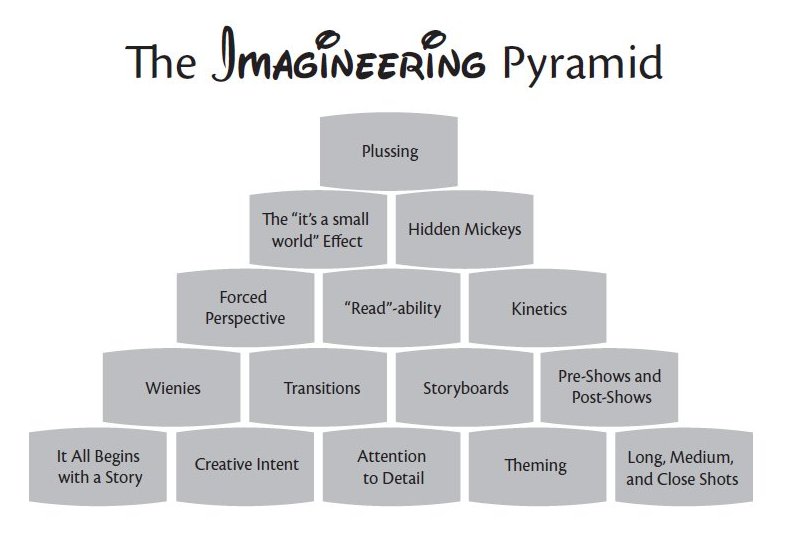Imagineering = Imagination + Engineering … How Disney keeps the magic alive, using the power of “plussing” to create more human, engaging, living experiences
August 22, 2023

Walt Disney was never satisfied with making movies.
To him, the idea of a theme park gave so much more scope to add value, to be more relevant and engaging with your audience, and to keep the experience alive.
“A picture is a thing that once you wrap it up and turn it over to Technicolor, you’re through. Snow White is a dead issue with me” he said.
“I wanted something live, something that it could grow, something I could keep PLUSSING with ideas. The park is that. Not only can I add things, but even the trees will keep groving. The thing will get more beautiful every year. I can’t change that picture, so that’s why I wanted that park.”
Disney created “imagineering” as a toolkit for achieving this.
Today, Walt Disney Imagineering is the creative engine that designs and builds all Disney theme parks, resorts, attractions, and cruise ships worldwide, and oversees the creative aspects of Disney games, merchandise product development, and publishing businesses.
At the heart of this process is the “Imagineering Pyramid”.
Even if you’re not building a theme park, the Imagineering Pyramid can help you plan and achieve any creative goal. The pyramid is formed from from the essential building blocks of Disney Imagineering, and teaches you how to apply the pyramid to your next project, how to execute each step efficiently and creatively, and most important, how to succeed.
The principles in the Imagineering Pyramid each fall into one of five categories or groupings, each of which forms a tier within the pyramid.

The tools for imagineering are then an arrangement of fifteen important Imagineering principles, techniques, and practices used by the company in the design and construction of Disney theme parks and attractions.

Tier 1: Foundations of Imagineering
The bottom tier of the pyramid includes the foundations, or “cornerstones”, of Imagineering. These principles serve as the base upon which all other techniques and practices are built. There are five Imagineering foundations:
- It All Begins with a Story – Using your subject matter to inform decisions about your project
- Creative Intent – Staying focused on your objective
- Attention to Detail – Paying attention to every detail
- Theming – Using appropriate details to strengthen your story and support your creative intent
- Long, Medium, and Close Shots – Organizing your message to lead your audience from the general to the specific
Tier 2: Wayfinding
The second tier is focused on navigation and guiding and leading the audience, including how to grab their attention, how to lead them from one area to another, and how to lead them into and out of an attraction. The four Wayfinding principles include:
- Wienies – Attracting your audience’s attention and capturing their interest
- Transitions – Making changes as smooth and seamless as possible
- Storyboards – Focusing on the big picture
- Pre-Shows and Post-Shows – Introducing and reinforcing your story to help your audience get and stay engaged
Tier 3: Visual Communication
The third tier includes techniques of visual communication that are used throughout the parks in different ways. You’ll find examples of these in nearly every land and attraction. These principles include:
- Forced Perspective – Using the illusion of size to help communicate your message
- “Read”-ability – Simplifying complex subjects
- Kinetics – Keeping the experience dynamic and active
Tier 4: Making It Memorable
The fourth tier includes practices focused on reinforcing ideas and engaging the audience. It is the use of these techniques which helps make visits to Disney parks memorable. These include:
- The “it’s a small world” Effect – Using repetition and reinforcement to make your audience’s experience and your message memorable
- Hidden Mickey’s – Involving and engaging your audience
Tier 5: Walt’s Cardinal Rule
The top tier contains a single fundamental practice employed in all the other principles. I call it “Walt Disney’s Cardinal Rule”:
- Plussing – Consistently asking, “How do I make this better?”
The Disney+ documentary series, The Imagineering Story, has also been published as a new book that greatly expands on Leslie Iwerks’ movie of the fascinating history of Walt Disney Imagineering.
The legacy of Walt Disney Imagineering is covered from day one through future projects with never-before-seen access and insights from people both on the inside and on the outside. So many stories and details were left on the cutting room floor, the book allows an expanded exploration of the magic of Imagineering, including:
Sculptor Blaine Gibson’s wife used to kick him under the table at restaurants for staring at interesting-looking people seated nearby, and he’d even find himself studying faces during Sunday morning worship. “You mean some of these characters might have features that are based on people you went to church with?” Marty Sklar once asked Gibson of the Imagineer’s sculpts for Pirates of the Caribbean. “He finally admitted to me that that was true.”
In the early days, Walt Disney Imagineering “was in one little building and everybody parked in the back and you came in through the model shop, and you could see everything that was going on,” recalled Marty Sklar. “When we started on the World’s Fair in 1960 and 1961, we had 100 people here. And so everybody knew everything about what was happening and the status of [each] project, so you really felt like you were part of the whole team whether you were working on that project or not. And, you know, there was so much talent here.”
Here’s a one page summary of imagineering by the illustrator Jeremy Waite:

More from the blog